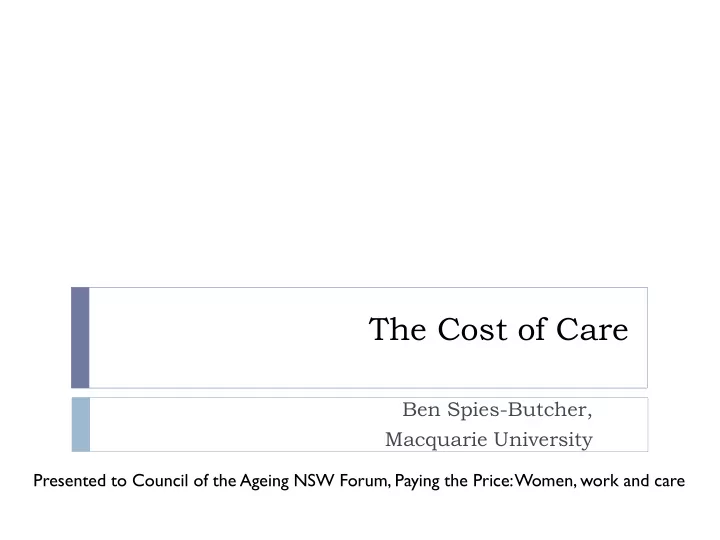

The Cost of Care Ben Spies-Butcher, Macquarie University Presented to Council of the Ageing NSW Forum, Paying the Price: Women, work and care
Overview The dilemma of care Breadwinner families: the post-War solution The end of an old model, in search of a new one Women and work Blending families Changing policy environment Saving for retirement Women, care and the life course Current issues: super and pensions Emerging issues: housing and elder care
What is care? Caring for old and sick Raising Everyday children care Care work
Paying for care Care expresses emotional connections: love, friendship, devotion The nature of that relationship can change if we pay for care as a service Care has been seen as an innate attribute of women, rather than an economic skill There is a trade off between unpaid care work and engagement in the labour market and leisure time How do we place an economic value on care?
The dilemma of valuing care We value care as We undervalue a social care as an relationship economic service
The Post-War Solution Market income Male Female Breadwinner Housewife Unpaid care work
Jobs at the centre Family wage Job Fulltime Fulltime Housewife Permanent
Jobs and Housing: providing over time Some get Public housing investment direct Competing Subsidised against single deposits incomes Controlled Stable Housing interest rates fulltime job
What’s Changed? Breadwinner model has broken down Women take on more paid work (men don’t reciprocate) Rise of blended families Policy settings change Labour market is less secure and hours less standardised Shift in policy towards private provision and insurance Changes to housing policy make it harder for young buyers Work doesn’t suit carers Lifetime savings doesn’t suit carers
Unpaid care 35% 30% 25% 20% Men 15% Women 10% 5% 0% >15 hours housework Care for person with Childcare disability Source: ABS, 2011 Census, 2001.0, Tables 20-22.
Gender and pay 100 Women get less 90 80 70 FT non-management 60 FT + O/T 50 All FT workers 40 All Workers 30 Super @ 55-65yo 20 10 0 Women's pay as a % of Men's pay Sources: ABS 6302; Wilkins et al. 2009 HILDA Statistical Report
Proportion living on super in retirement 25 20 15 Men Women 10 5 0 2003/4 2005/6 2007/8 2009/10 20011/2 Sources: ABS 2014, Gender Indicators, 4125.0
Housing as Private Savings Later papers will explore super and labour market incomes more, now I turn to housing Wage earner model sees access to housing as linked to stable full-time employment Deposit savings pre-marriage; higher wages facilitate mortgage repayments Home ownership supports retirement income matched with low flat pension Home ownership appears egalitarian: skewed to those in retirement who now have low incomes but high savings
Tenure type by main source of income 60 50 40 Own outright Mortgage 30 Public renter Private renter 20 10 0 Workers Business income All pensions Source: ABS 6523.0, Table 9
Home ownership over time T enure T ype All Households 45 40 35 30 25 20 15 10 5 0 94/5 96/7 99/00 00/1 02/3 05/6 07/8 09/10 11/12 Own ourtight Buying Public rental Private rental Source: ABS 4130.0, Figure 2.
Housing tenure, those over 65 Housing tenure for individuals aged 65+ years, 2001 to 2012 2000/01 2011/12 Change Housing Tenure (%) (%) (%) Owner 80.7 76.3 -4.4 Mortgagee 3.6 7.5 +3.9 Private renter 5.1 7.4 2.3 Public renter 6.0 4.7 -1.3 Source: ABS 4130.0, various years.
Housing tenure, those aged 35-44 years 2000/1 2011/2 Change Housing Tenure (%) (%) (%) Owner 17.1 6.8 -10.3 Mortgagee 52 55.3 3.3 Private renter 23 31 8.0 Public renter 5.4 3.5 -1.9 Source: ABS 4130.0, various years.
Housing tenure, couples without kids 2000/1 2011/2 Change Housing Tenure (%) (%) (%) Owner 54.3 45.9 -8.4 Mortgagee 27.7 31.1 3.4 Private renter 13.4 18.4 5.0 Public renter 1.9 1.5 -0.4 Source: ABS 4130.0, various years.
Housing tenure, couples with oldest child 5-14 2000/01 2011/2 Change Housing Tenure (%) (%) (%) Owner 20.6 9.4 -11.2 Mortgagee 58.8 62.3 3.5 Private renter 15.3 24.2 8.9 Public renter 3 1.5 -1.5 Source: ABS 4130.0, various years.
Housing tenure for single parent households 2000/1 2011/2 Change Housing Tenure (%) (%) (%) Owner 13.8 7.3 -6.5 Mortgagee 26.5 29.2 2.7 Private renter 40.7 47.8 7.1 Public renter 15.9 11.3 -4.6 Source: ABS 4130.0, various years.
Proportion of people who are primary carers for older person or person with disability 12.0 10.0 8.0 Men 6.0 Women 4.0 2.0 0.0 Age25-34 Age35-44 Age45-54 Age55-64 Age65-7 Aged >75 Source: ABS 2013, Disability, Ageing and Carers Australia 2012, 4430.0, Table 33.
Looking after each other in later life Number of Carers, Relationship to Recipient 90 80 70 Number ‘000 60 50 40 30 20 10 0 Partner aged Partner aged Child aged 25- Child aged 45- 45-64 65+ 44 64 Men 56.9 72.8 12.5 30 Women 79.9 82.3 32.1 79.5 Source: ABS 2013, Disability, Ageing and Carers Australia 2012, 4430.0, Table 39.
Recommend
More recommend